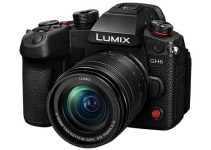We’ve come a long way in the last decade. From SD to HD, and now making a quantum leap into 4K resolutions and beyond, it sometimes makes me wonder where do we go from here. There are numerous improvements required on many fronts, one of them being availability of 4K content and increased demand from consumers, but it time this will happen as we have the acquisition and display tools on hand.
4K TV sets started popping up just in the last two three years, but display technology has already made significant improvements. Today, prices on consumer 4K displays are constantly falling, and it won’t be long before we see very good quality 4K TV’s at reasonable prices.
However, as the so-called “K” wars (or resolution wars if you want to call them) continue between camera manufacturers, consumer perception and reactions to 4K as the next home entertainment standard seem to be mixed at best. Many consumers cannot even distinguish between HD and 4K content displayed on a 40+ inch TV, which is one of the major arguments against the need for 4K TVs.
So, does 4K really have an impact on the human eyesight, and can we really benefit from a 4K (UHD) viewing experience?
In this post, we’ll consider some factors which affect 4K viewing and our human visual perception, in order to achieve a more worthy viewing experience. Below we’ve included some insights on the subject, courtesy of the learning resources on RED.com
- Viewing Distance & Angular Resolution
Human visual perception of detail does not solely depend on the ability of our eyes to resolve the smallest features in a given subject, but also depends on the distance between us and the object being projected. Human vision is generally described in terms of “angular resolution” as on the graph below:
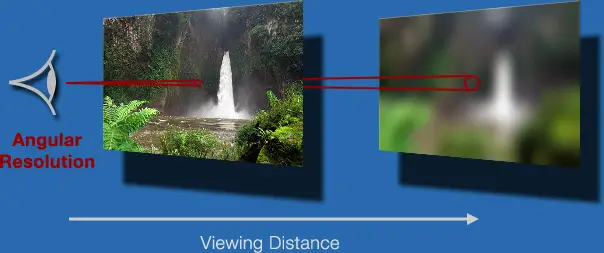
Being able to resolve lines in characters that are separated by 1/60th of a degree (an “arc minute”) is the goal when testing eyesight. Since this resolution is typically assessed using an eye chart at a distance of 20 feet, this level of performance is defined as 20/20 vision. Similarly, 20/50 means one can only resolve detail that someone with 20/20 vision could resolve from 50 feet away. Alternatively, with the metric system these are all standardised around 6 meters and referred to as 6/6 vision instead.
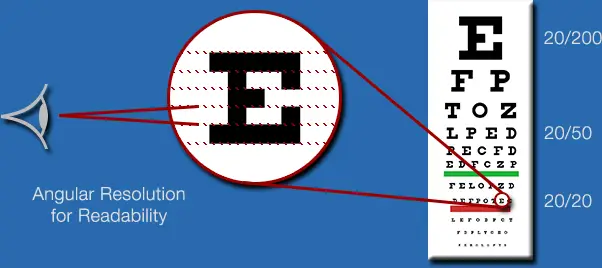
Although 20/20 is a reasonable capability for someone with good eyesight, this is by no means a limit. Each viewer fits in differently amongst the full spectrum of visual capabilities. Healthy eyes or someone with glasses may actually resolve substantially more. Furthermore, the visual capabilities required for discerning text are typically much higher than those required for perceiving additional detail.
- 4K Resolution & Viewing Angle
Photography, and fine art prints usually use about 300 (ppi) pixels per inch, which means that a the optimal viewing distance of one foot is required for a person with a 20/20 vision to resolve the detail in the 300 ppi print.
However, the interesting part is that these pixels are not always so densely packed together. The standard rule of thumb with enlargements is that these will be viewed at a distance similar to the diagonal print dimension.
This causes the print to encompass an angle of view spanning about 50° in its longest dimension:

Although these viewing angles are not always possible or practical, they are usually where someone will stand for an immersive viewing experience. At the same angle of view, one may therefore prefer being closer to a smaller screen, but further from a larger one.
It seems rather intuitive, and the reason for this is because “this angle closely matches the 40-60° central angle of view of our own eyes“:
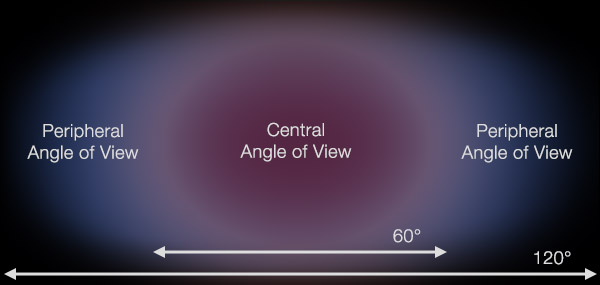
Filling this angle helps the viewer feel more as though they are within a scene as opposed to looking at it inside a rectangle. In effect, higher resolution enhances the sense of detail, whereas wider viewing angles enhance the sense of “being there.” Both are needed to enhance the sense of realism.
The main take-away from this exercise is:
- The more the Viewing Angle increases, regardless of whether due to a larger projected image or the viewer moves closer to the screen – the Resolvable Pixels also increase.
If we apply those viewing angles to the home cinema experience – we can see that HD TV’s appear pixelated, hence 4K resolution or higher is required to produce maximally sharp and seemingly continuous pixels for most viewers. The graph below illustrates this. Data is from the The Health and Nutrition Examination Survey of 1972 conducted in the US.
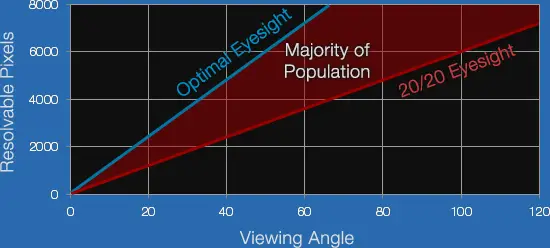
The Health and Nutrition Examination Survey of 1972 demonstrated that 72.8 percent of the civilian non-institutionalised population 4-74 years of age in the United States has distance visual acuity of at least 20/20 in their better eye “with usual correction” (using glasses and other visual aids).
Now, in the cinema, with a theatrical screen, relative viewing distances are often a little closer, depending of course where you sit in the cinema. Widescreen aspect ratios (2.39:1 or 1.85:1) may also be intended to extend into the viewer’s peripheral vision.
Makes sense for most of us seeking the ultimate viewing angle to choose a seat towards the middle of the cinema, where our eyes are about levelled to the horizon line on the screen and we are approximately sitting at least a 1 x or 1.5 to 2 x the size of the screen.
As such, our viewing angle is between a 45-60° angle of view. On the other hand seats near the front can result in 90° or higher, see diagram below:
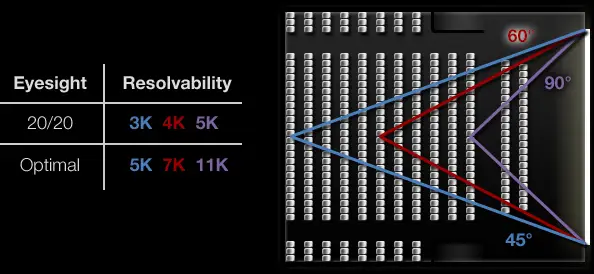
The diagram above depicts a typical large-screen theater with a 70 foot (21.3 meter) screen width. Although the IMAX, GSCA and other large-screen specifications recommend a minimum viewing distance of one screen width (53° viewing angle), the seating rows above extend out to a viewing angle of 45°. Even then, note how the majority of viewers can resolve more than 2K resolution from every seat in the theater.
- Further Considerations
It is natural to look for further resolution detail in our quest for the ultimate viewing experience. The human eye is a one of the most complex and wonderful organs in the human body and even though those of us who are blessed with the ability to see may take it for granted, and getting more pleasing and natural pictures from displays and cinema screens would benefit our viewing experience.
When everything else is in place, display technology should maximize these conditions to ensure the highest fidelity possible. Tablets and notebooks now exceed 1080P, and even smart phones are beginning to have 1080P displays. Depicting more detail with cinema is a natural next step.
In addition, 4K content is only one of several factors contributing to our perception of detail.
Cameras, lenses and focusing technique need to be considered and also get to a higher standard for 4K resolutions and above. There are numerous lenses out there for 4K acquisition from Zeiss, Xenon and ARRI, but the film industry is moving in the right direction and recognising as the imminent future for professional film production.
Oversampled recordings are also helpful for making the most of a given pixel count. Only when all of these pieces are in place will the 4K viewing experience have its maximal effect.
Disclaimer: As an Amazon Associate partner and participant in B&H and Adorama Affiliate programmes, we earn a small comission from each purchase made through the affiliate links listed above at no additional cost to you.


